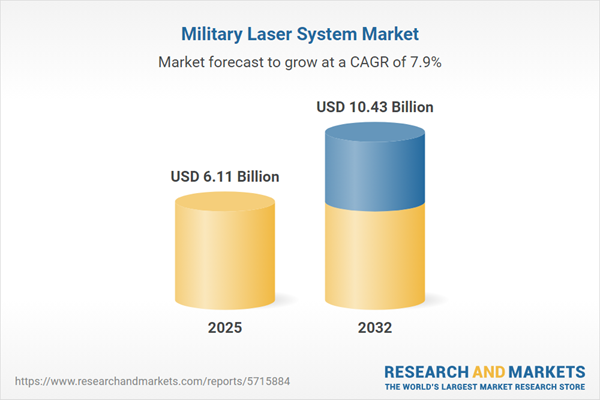Speak directly to the analyst to clarify any post sales queries you may have.
The military laser system market is rapidly evolving, with advanced laser technologies reshaping defense capabilities and providing adaptable solutions for complex security environments. Senior leaders now consider these systems essential in strengthening both strategic and tactical operations across global defense sectors.
Market Snapshot: Military Laser System Market Growth
Driven by expanding requirements in precision targeting, secure communications, and multi-domain operations, the military laser system market is experiencing heightened global activity. The worldwide market is forecast to advance from USD 5.67 billion in 2024 to USD 6.11 billion in 2025, with an expected valuation of USD 10.43 billion by 2032 at a 7.92% CAGR. This growth reflects rising investments in directed energy technologies, robust procurement pipelines, and comprehensive modernization programs spanning air, land, sea, and space domains. Armed forces are implementing military laser solutions to meet new operational imperatives, shifting toward modular architectures that simplify system upgrades, respond to dynamic threat environments, and encourage stronger allied cooperation.
Scope & Segmentation: Military Laser System Market
This report offers structured insight into current and emerging segments to help senior stakeholders align investments and capability planning with evolving defense strategies. Each segment supports operational agility and encourages innovation for effective future responses.
- Technology Types: Chemical, fiber, free electron, gas, semiconductor diode, and solid-state lasers address applications such as targeting, secure communications, electronic countermeasures, and enhanced situational awareness, each chosen for mission-specific suitability.
- Platforms: Airborne, ground-based, naval, and space-based deployments provide flexibility to tailor systems for joint or multi-domain missions and enable rapid adaptation to new operational theaters.
- Applications: Strategic needs are met through solutions for military communications, directed energy weapon integration, aerial threat mitigation, border surveillance, rangefinding, and target recognition, all supporting organizational readiness.
- Operation Modes: Continuous wave, pulsed, multi-frequency, single-frequency, mode-lock, and Q-switch options deliver operational versatility by addressing diverse mission demands and tactical environments.
- Power Output Categories: Ranging from below 10 KW up to above 100 KW, power output options enable both precision engagements and wide-area defense, ensuring scalability and mission fit.
- Mobility Types: Fixed, mobile, man-portable, and vehicle-mounted systems support a broad scope of operational concepts, from rapid response to long-duration assignments, in conventional and asymmetric settings.
- End Users: Air Force, Army, Navy, Marine Corps, and specialized defense agencies leverage tailored deployment plans to maximize operational effectiveness in line with their unique requirements.
- Regions Covered: Markets in the Americas, Europe, Asia-Pacific, and Middle East and Africa are shaped by region-specific defense postures, investment climates, and technology adoption, presenting differentiated growth dynamics and requirements.
- Key Companies: Market participants include Lockheed Martin Corporation, Raytheon Technologies Corporation, Northrop Grumman Corporation, BAE Systems Plc, The Boeing Company, L3Harris Technologies, Rheinmetall AG, Rafael Advanced Defense Systems, MBDA, and General Atomics Corporation, contributing to diverse offerings and sustained sector innovation.
Key Takeaways for Decision Makers
- The integration of advanced directed energy solutions reshapes command, control, and communication capabilities, supporting accelerated response cycles and enhancing preparedness.
- Modular system designs streamline ongoing maintenance and upgrades, equipping forces with the agility required to quickly address shifting mission needs across various infrastructures.
- Incorporation of artificial intelligence elevates targeting precision and expands autonomous functionalities, unlocking new possibilities in military laser technology and supporting adaptable operation concepts.
- Resilient supply networks bolster acquisition flexibility and protect against disruptions, ensuring continuous access to mission-critical elements throughout global defense value chains.
- Customizable platforms promote swift adaptation to emerging threats, extending the operational relevance of military assets and helping sustain high mission success rates amid dynamic security environments.
Tariff Impact: United States Tariff Policy Effects on Supply Chains
Amendments to U.S. tariff policy are affecting procurement processes within the military laser system supply chain. There is growing emphasis on strengthening domestic production and collaborating with certified suppliers to support consistent operations and meet regulatory expectations.
Methodology & Data Sources
This analysis is grounded in executive interviews, procurement leader perspectives, and insights from defense technology experts. Credibility is reinforced through reference to military documents, peer-reviewed publications, technical whitepapers, and independent patent assessments to inform senior decision-making.
Why This Report Matters
- Empowers leadership to calibrate procurement and capital allocation with shifting military priorities and complex defense environments.
- Clarifies technological trends and regional shifts for risk management and resilient long-term investment strategies in defense modernization.
- Provides actionable intelligence to inform adaptive planning and foster stronger outcomes in global defense operations.
Conclusion
Widespread adoption of military laser systems is redefining defense strategies and enabling organizations to address emerging threats. This report delivers the insights leaders need to drive continual advancement in operational effectiveness.
Additional Product Information:
- Purchase of this report includes 1 year online access with quarterly updates.
- This report can be updated on request. Please contact our Customer Experience team using the Ask a Question widget on our website.
Table of Contents
3. Executive Summary
4. Market Overview
7. Cumulative Impact of Artificial Intelligence 2025
Companies Mentioned
The companies profiled in this Military Laser System market report include:- Lockheed Martin Corporation
- Raytheon Technologies Corporation
- Northrop Grumman Corporation
- BAE Systems Plc
- The Boeing Company
- L3Harris Technologies, Inc.
- Rheinmetall AG
- Rafael Advanced Defense Systems Ltd.
- MBDA
- General Atomics Corporation
Table Information
| Report Attribute | Details |
|---|---|
| No. of Pages | 186 |
| Published | October 2025 |
| Forecast Period | 2025 - 2032 |
| Estimated Market Value ( USD | $ 6.11 Billion |
| Forecasted Market Value ( USD | $ 10.43 Billion |
| Compound Annual Growth Rate | 7.9% |
| Regions Covered | Global |
| No. of Companies Mentioned | 11 |









